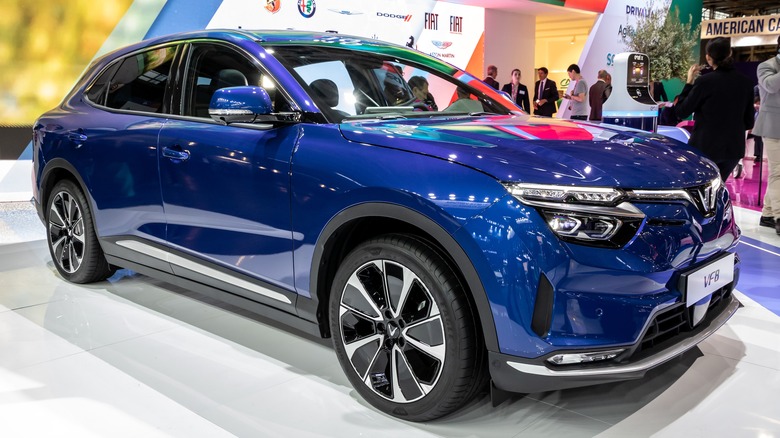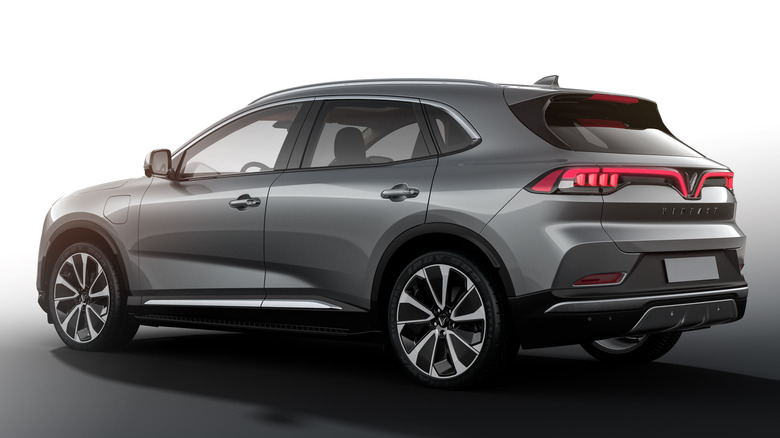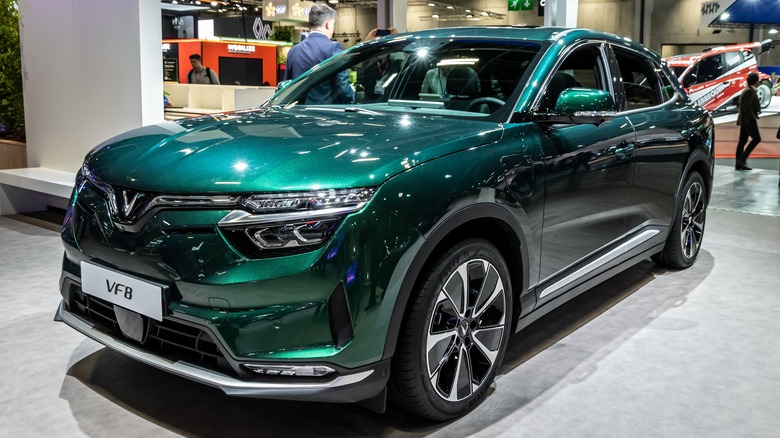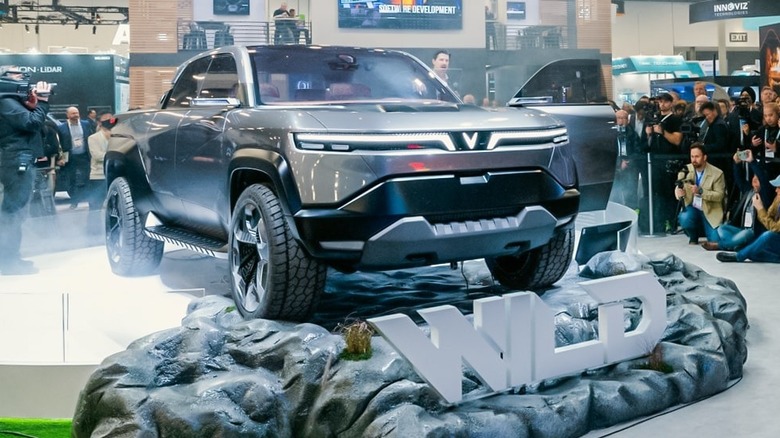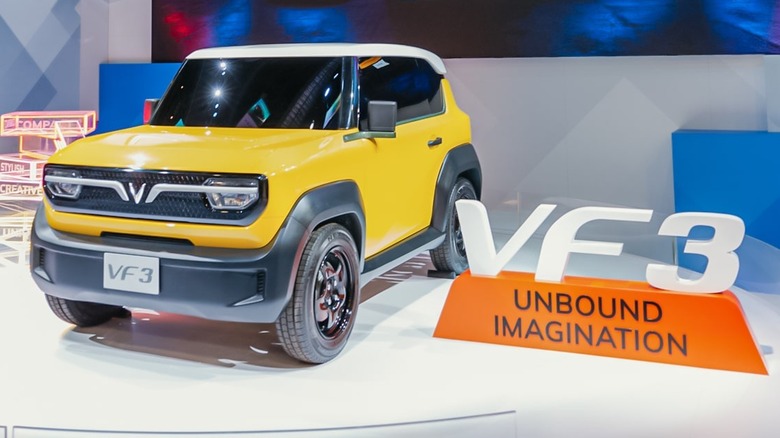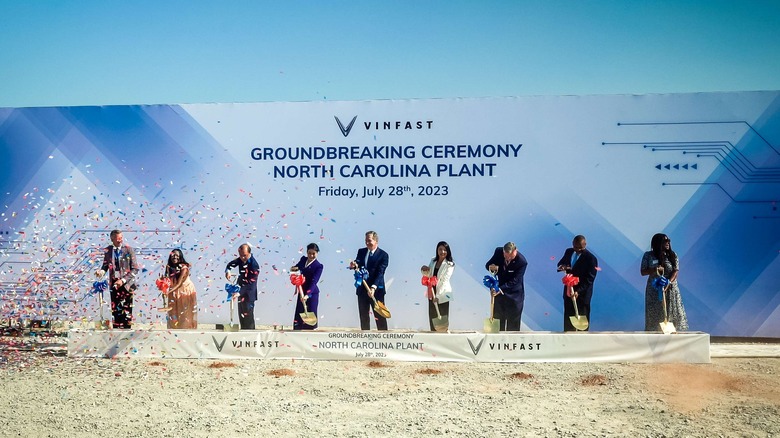Everything You Need To Know About VinFast, America's Newest Automotive Import
VinFast is the automaking subsidiary of billion-dollar Vietnamese conglomerate Vingroup, a huge corporate entity in Vietnam. The company is run by Pham Nhat Vuong, who initially made his fortune in instant noodles, then followed that up with another fortune in real estate. The Vingroup empire spans theme parks, resorts, food and clothing stores, cell phones, apartments, hospitals, schools and universities. It also has divisions specializing in AI and Big Data, which will contribute to VinFast's intelligent driving systems.
VinFast began making cars in 2017, with sales commencing in 2019. At that time, the rate of car ownership in Vietnam was very low at only 23 cars per 1,000 people. The company started out by contracting Italian design house Pininfarina to rebody existing vehicles, such as the BMW 5-Series and X5, as well as the subcompact Chevrolet Spark. Thanks in part to import duties on vehicles from outside Vietnam, VinFast's first vehicles were local best-sellers.
In early 2022, VinFast decided on a major change of course. They would stop producing vehicles with internal-combustion engines (ICE) and would instead become a full-line electric vehicle (EV) manufacturer.
VinFast chose to become vertically integrated, making the vast majority of parts themselves. In addition to cars and SUVs, VinFast also produces e-scooters, e-buses, battery systems, and vehicle charging stations for Vietnam. However, VinFast's path to becoming a purveyor of competitive EVs has been a bit bumpy, to say the least.
VinFast's plans go far beyond their home market
While VinFast definitely intends to bring the benefits of EVs to its home country of Vietnam, it also has plans to export them around the world. By May of 2023, VinFast was ready to begin its assault on the U.S. EV market with its VF8 crossover. The company's first shipment of 999 City Edition versions of the VF8 arrived. Automotive journalists from SlashGear and other publications drove and evaluated them.
Impressions from the VinFast VF8 first drive were a mixed bag. While the VF8 was nicely styled by Pininfarina, with prominent V elements front and rear, its design was not distinctive when compared to other vehicles of its type. The initial batch came with a smaller-than-standard battery which provided limited range, but aside from a 54-horsepower boost in the more powerful version, the two trim levels were nearly identical.
Inside the VF8, the interior was drab, with a Tesla-like center screen and no instrument panel in front of the driver — although a heads-up display (HUD) was used to project information onto the windshield. The front seats looked good and had many controls, but lacked support and comfort. Many functions are controlled through numerous menus and submenus in the large center touchscreen, requiring the driver to look away from the road to operate them. The factory-supplied stereo system did not sound good. The navigation system acted as though it was still in Vietnam. The HUD had no indicators for the turn signals, leaving the driver to wonder whether or not they were working.
The VinFast VF8 may not be ready for prime time
On the road, the VinFast VF8 was reported to have unsettled chassis dynamics, causing some testers to get carsick. Throttle response was sluggish in any setting besides Sport, leaving an impression that the car was severely underpowered. The steering was non-linear with no feedback.
The VF8 also comes with the standard suite of advanced driver assistance systems (ADAS) similar to most contemporary vehicles. The adaptive cruise control worked well, but the lane-keeping assist and blind spot warning did not. Overall, the VF8 exhibited many bugs to be worked on if the company wants sales success in the U.S.
In terms of service, support, and warranty, the VinFast VF8 offers over-the-air updates and a 10-year/125,000 mile warranty with 24/7 roadside assistance that covers every part in the car. The battery pack comes with a 10-year/unlimited mileage warranty. Current pricing for the VF8 is $46,000 for the Eco trim, and $51,800 for the Plus.
Actual sales figures are another issue of concern. While the company noted that fewer than 1,000 units were sold in North America, another report stated that while VinFast had shipped 3,118 cars to the U.S., only 265 had been sold as of December 2023. Most of the rest are stored at the port. It could be assumed that VinFast's sales problem is tied directly to its quality and performance issues.
VinFast has more models in the pipeline
The likely next model to come to the U.S. is VinFast's VF9, a three-row SUV. It is available for reservation on the VinFast website at a cost of $69,800 for the Eco trim and $73,800 for the Plus trim. While both trims have 402 horsepower, the Plus has added luxury features, as well as a shorter range of 291 miles, compared to the 330 miles for the Eco. This may be due to the larger 21 inch wheels on the Plus.
VinFast has shown the concept version of its new mid-size electric pickup truck, the VF Wild, at CES 2024 in Las Vegas. It was jointly designed with GoMotiv, an Australian design studio. The Wild is an EV that features a mid-gate design that allows the interior to be opened up for additional cargo storage. It could be released in 2026 and would compete with the mid-size Rivian R1T pickup. Cost has been estimated at $45,000.
Also revealed at CES 2024 was the production model of the cute VinFast VF3, a mini SUV. At just over ten feet long, it is designed to be an entry-level EV. The VF3 comes with a 32kW motor with 43 horsepower and an 18kWh battery. Range is estimated at 130 miles. The VinFast VF3 was initially offered in Vietnam at a special promotional price of the local equivalent of $9,248 excluding battery, or $12,390 with battery included.
VinFast changed its sales model - will it help?
VinFast was originally going to use a direct-to-consumer sales model, like Tesla. However, unlike Tesla, VinFast's 15 California company stores and service centers produced poor sales results. Now, VinFast is adding existing dealers to its sales network. The company also hinted that it could eventually sell its company stores to dealers. VinFast calls this a "capital-light hybrid model."
This move illustrates the financial challenges facing a new, untested EV entrant, from a developing country, that is trying to break into a mature market where all of the established players already have a solid foothold. It takes billions of dollars and very good products to compete in the global automotive industry. When you start with a vehicle like the VF8 that is not fully developed, you have a recipe for disaster, as consumers will run from a product if it does not work properly. Starting out with a reputation for poor quality could be the end of VinFast before it has a chance to establish itself in the U.S.
That being said, an apparent indicator of VinFast's belief in its future in the U.S. market was its July 2023 groundbreaking for a new $4 billion auto plant located in North Carolina. This factory is slated to produce 150,000 EVs annually when it is completed in 2025. However, as of April 2024, no further work had been done at the site, calling its ultimate completion into question.
VinFast may yet be able to save itself
VinFast is a young company with ambitious goals, but it has faced problems during its initial foray into the U.S. market. Regaining a position of serious consideration by EV shoppers in the U.S. is of supreme importance to this nascent brand. Having lots full of unsellable cars is not the way forward to future success.
If VinFast is able to fix the VF8's problems and re-introduce the vehicle, they might be able to resume their upward trajectory. The company's slate of upcoming EVs seems to be well thought-out and right for the U.S. market, but only time will tell how the VinFast story plays out.
VinFast could learn from Hyundai's history in the American marketplace. Hyundai had a similar experience in the late 1980s and early 1990s, when quality problems nearly drove them out of the U.S. market. A dedication to flawless products, backed with a superior 10-year/100,000-mile powertrain warranty, put Hyundai back to the top.
